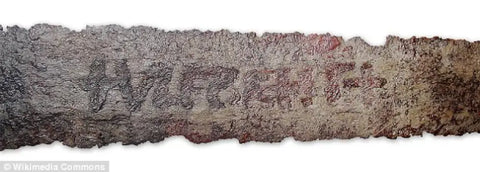Your Cart is Empty
Menu
-
- Shop by Type
- End of Line Sale Items
- New In
- Viking Gifts Under $30
- Hand Forged Axes
- Silver Viking Jewelry
- Stainless Steel Jewelry
- Cremation Jewelry
- Necklaces and Pendants
- Hand Carved Wooden Pendants
- Kings Chains
- Viking Drinking Horns
- Pendant Chains
- Rings
- Bracelets
- Earrings
- Beard Beads and Beard Rings
- Collectables
- Ceramic Mugs
- Street Wear
- Horn Jewelry
- Bronze and Pewter Jewelry
- Shop by Theme
- Viking Axe
- Celtic Jewelry
- Dragon or Serpent
- Viking Raven
- Wolf / Fenrir
- Rune Jewelry
- Odin Jewelry
- Ram / Goat
- Shieldmaidens / Lagertha
- Sword, Spear or Arrow
- Thor's Hammer / Mjolnir
- Tree of Life / Yggdrasil
- Helm of Awe / Aegishjalmur
- Triquetra or Triskelion
- Valknut / Knot of Slain
- Vegvisir / Viking Compass
- Veles / Bear
- Blogs
- Help
-
- Login

The Super-strong 'Ulfberht' Viking Sword

A small number of 'super-strong' Viking swords have been uncovered that are forged of metal so pure that researchers are currently unable to explain how they were made with the technology believed to be available at the time. To add to the mystery, all of the weapons are inscribed with a single word - 'Ulfberht'
It was the sword of choice for the discerning Viking - super-strong, and almost unbeatable in battle. Yet mystery surrounds a small number of Viking swords uncovered in archeological excavations.
They are all inscribed with a single word - 'Ulfberht', which experts believe may reveal their maker.

a single word - 'Ulfberht' - on the blade of a Viking sword. Experts believe a German monastry may have been responsible for the product of the super-strong weapons.
About 170 Ulfberhts have been found in total, dating from 800 to 1,000 A.D. They are made of metal so pure it baffled archaeologists, who thought the technology to forge such metal was not invented for another 800 or more years, during the Industrial Revolution.
In the process of forging iron, the ore must be heated to 3,000 degrees Fahrenheit to liquify, allowing the blacksmith to remove the impurities, known as 'slag'. Carbon is also mixed in to make the brittle iron stronger.
Current thinking is that Medieval technology did not allow iron to be heated to such a high temperature, so slag was removed by pounding it out, a far less effective method.
The Ulfberht, however, has almost no slag, and it has a carbon content three times that of other metals from the time.
However, new research is helping to get closer to the source of the swords, and possibly even to the kiln in which these legendary weapons were forged.
Alan Williams of the Wallace Collection in London has studied the blades, and believes the maker is unique.
'It's much like putting the 'Apple' name on a computer,' he said.
They were extremely rare and valuable, and would have been prized possessions of the most elite Vikings.
Robert Lehmann, a chemist at the Institute for Inorganic Chemistry at the University of Hannover, studied an Ulfberht sword found in 2012 on a pile of gravel excavated from the Weser River, which flows through Lower Saxony in northwestern Germany.
This sword's blade has a high manganese content, which signalled to Lehmann that it did not come from the East.
The guard was made of iron with a high arsenic content, which suggests a European deposit.
He traced the lead to a site in the Taunus region, just north of Frankfurt, Germany - where he believes it may have been made.
Whilst this doesn't explain how the swords were made it does at least get us closer to where they were made.
